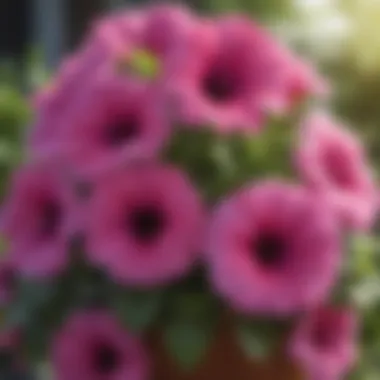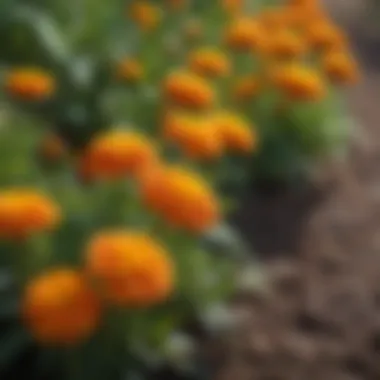Best Spring Annual Flowers for Your Garden


Intro
Spring is a time of renewal, and for gardening enthusiasts, it represents the perfect opportunity to breathe life into their outdoor spaces. Choosing the right annual flowers is crucial for creating a vibrant and lively garden. This guide will delve into the best annual flowers for spring, focusing on their unique characteristics, ideal conditions for growth, and detailed care tips.
Understanding the factors that influence flower selection is essential. Each flower has its own set of requirements concerning sunlight, soil type, and watering frequency. Moreover, integrating the right color palettes can enhance the aesthetic appeal of your garden. Whether you are a novice gardener or possess years of experience, this guide aims to equip you with the knowledge needed to cultivate a thriving garden.
Design Inspiration
Creating a visually appealing garden often begins with understanding the current trends in planting designs. This year, more gardeners are gravitating towards a balanced mix of wildflower aesthetics with structured planting. Curated bursts of color combined with natural formations often draw the eye and add depth.
Color Schemes and Palette Ideas
Color selection plays a significant role in garden design. Popular color schemes this season include:
- Monochromatic: Utilizing various shades of the same color, this scheme creates a harmonious look.
- Complementary: Pairing colors opposite each other on the color wheel generates vibrancy.
- Analogous: Combining colors next to each on the wheel creates a serene and cohesive appearance.
Each of these schemes offers opportunities for creativity and personalization. Consider how petunias, marigolds, and zinnias can be arranged to achieve a desired visual impact.
Gardening Techniques
Effective gardening techniques can significantly impact your success. Understanding how to choose the right plants and care for them is pivotal.
Plant Selection and Care
When selecting plants, it is vital to consider the local climate, soil quality, and the amount of sunlight the area receives. Annual flowers such as pansies, snapdragons, and geraniums are popular during spring due to their resilience and vibrant blooms.
- Watering Needs: Establish a routine for watering that matches with the requirements of the selected flowers.
- Fertilization: Use a balanced fertilizer to support growth and blooming.
- Pruning: Regularly remove dead flowers to encourage the production of new blooms.
Indoor vs. Outdoor Gardening
The choice between indoor and outdoor gardening can depend on space and personal preference. Indoor gardening allows for controlled conditions, ideal for beginner gardeners. Outdoor gardening, on the other hand, can accommodate more extensive collections and foster a connection with nature. Whichever route you choose, understanding the nuances of each will enhance your gardening journey.
"Gardening is not just about making your surroundings beautiful, it is also a path to personal tranquility."
This article aims not only to guide you in selecting and caring for spring annual flowers but also to inspire you to create an outdoor environment that reflects your style and personality.
Preface to Spring Annual Flowers
Spring annual flowers are pivotal in the gardening landscape. These vibrant plants offer immediate beauty and color, transforming spaces with relative ease. For gardeners, particularly those less experienced, annuals serve as an excellent entry point. Their ability to bloom quickly and offer continuous color throughout the growing season can significantly enhance outdoor aesthetics.
The Importance of Annual Flowers
Annual flowers play a critical role in garden design. They provide seasonal pops of color, which can complement perennial plants and shift garden dynamics from one season to the next. Unlike perennials, annuals complete their life cycle in a single growing season, allowing gardeners to experiment with various colors and types each year without the long-term commitment. This flexibility appeals to many homeowners and gardening enthusiasts who desire to refresh their landscapes frequently.
Moreover, many annuals are specifically chosen for their abilities to attract pollinators like bees and butterflies, contributing to a healthier garden ecosystem. These flowers also have numerous uses, from borders and containers to focal points in a landscape. They can fill gaps created by other plants and provide a lush look even in limited gardening spaces.
Characteristics of Spring Annuals
Spring annual flowers exhibit several characteristics that make them unique and desirable. First, they generally prefer warmer temperatures that arrive with spring, typically thriving when the frost has passed. Most spring annuals have a fast growth rate, meaning they can fill in garden space quickly, giving instant visual gratification to the gardener.
Furthermore, these plants often come in multiple varieties, showcasing a wide array of colors and forms. This variety allows for creative combinations, where different flowers can be combined to create a unique and personalized garden design. Annuals are also known for their hardiness, adapting well to a range of soil types and conditions, which is invaluable for novice gardeners.
Spring annuals may require more frequent watering and care early in the season but are highly rewarding with their lush blooms. They also tend to have diverse blooming periods, ensuring that a garden remains vibrant for months.
In summary, understanding the traits and significance of spring annual flowers lays a foundation for creating successful and visually appealing gardens. By embracing the advantages of these plants, gardeners can curate spaces that reflect their personality and aesthetic preferences, ensuring that their environment is both vibrant and inviting.
Factors to Consider When Choosing Annual Flowers
Choosing the right annual flowers for your garden is not a trivial task. It involves understanding various factors that can affect the growth and beauty of your plants. Getting these elements right can lead to healthier plants and a more vibrant garden. By considering the characteristics of each flower along with your environment, you can create a flourishing outdoor space.
Climate and Hardiness Zones
Climate plays a significant role in the success of your annual flowers. Plants thrive in specific temperatures and environments. Understanding hardiness zones can help you select flowers that will flourish in your area.
The United States Department of Agriculture (USDA) has divided the country into several hardiness zones based on climate. For instance, some flowers such as zinnias may do well in warmer zones, while others like pansies prefer cooler climates. It's crucial to match the flowers you choose to your particular zone to ensure growth and blooming during the spring season.


In addition, factors like elevation and local weather patterns can also affect flower selection. A flower that thrives in a coastal region might struggle in the mountains. Therefore, researching and knowing local conditions is essential.
Sunlight Requirements
Another critical factor is understanding the sunlight needs of annual flowers. Flowers can be categorized into full sun, partial shade, or full shade based on their requirements. Most annuals prefer full sun, which means they need at least six hours of direct sunlight a day. Examples include petunias and marigolds.
Conversely, some flowers, like impatiens, do better in shady conditions. It's vital to evaluate the sunlight exposure in your garden to select flowers that will thrive. A site that gets morning sun but afternoon shade may well suit different plants than one that enjoys full sun all day. Observing how sunlight hits your garden can guide you in making the best choices.
Soil Type and Quality
The type of soil in your garden can have a considerable impact on the growth of your annual flowers. Different plants require different pH levels and soil textures to flourish.
For instance, zinnias prefer well-drained soil that is slightly acidic, while snapdragons can tolerate a broader range of conditions. Assessing your soil quality before planting is therefore important. You may want to conduct a soil test to determine its pH and nutrient content.
In some cases, you may need to amend the soil with organic matter or fertilizers to create an ideal environment for your plants. Adding compost, for example, can improve soil structure and provide nutrients, making it easier for roots to establish.
"Soil health greatly affects plant growth and survival in gardens. An informed approach can reap long-lasting rewards."
Top Spring Annual Flowers
Selecting the right spring annual flowers is crucial for any gardening enthusiast. These flowers can enhance the aesthetic appeal of any outdoor space. They are not only vibrant and colorful but also seasonally adaptive. Each flower type has distinct characteristics that cater to different gardening conditions and preferences. Understanding these flowers allows for better decision-making for design and maintenance, leading to successful gardening outcomes.
Petunias
Varieties and Colors
Petunias come in a wide range of varieties and colors. This makes them a very popular choice among gardeners. The extensive color palette includes shades of purple, pink, white, and blue. Their versatility allows for dynamic planting combinations. The bright blooms can enliven borders, beds, and containers alike.
The key characteristic of petunias is their ability to thrive in diverse conditions. This hardiness contributes to their widespread use. However, it's important to note that certain varieties may bloom more profusely than others. While their beauty is undeniable, gardeners should consider the type they select to ensure color continuity in their arrangements.
Growing Conditions
Petunias prefer full sun and well-drained soil. Their growth potential increases significantly under ideal conditions. They flourish with regular watering, but overwatering must be avoided to prevent root rot. Sunlight and soil quality are crucial elements for their growth, influencing vigor and bloom production.
A unique feature of petunias is their prolific flowering. This trait adds an element of brightness to gardens. However, they may require more care than some other annuals, as they can suffer from pests if neglected. Gardener should be vigilant about providing the correct environment for optimal growth.
Care Requirements
Care requirements for petunias include consistent watering and deadheading. Regularly removing spent flowers can promote further blooming. Additionally, a balanced fertilizer can enhance blossom production.
The main characteristic here is the need for timely maintenance. While they are not the most demanding flowers, routine care is key to their long-lasting performance. Failure to meet these care requirements can lead to diminished blooms, making it essential for gardeners to balance beauty with necessary upkeep.
Marigolds
Benefits for Pest Control
Marigolds are celebrated for their pest-repelling properties. They produce compounds that deter common pests like aphids and nematodes. This characteristic significantly benefits an overall garden health. By planting marigolds, gardeners can create a more resilient environment for other flowers and vegetables.
The key benefit is the natural pest control they offer. This makes them a practical choice for organic gardeners who prefer to avoid synthetic pesticides. Their attractiveness also draws beneficial pollinators, enhancing plant productivity.
Planting Tips
When planting marigolds, it's essential to choose a sunny location. They thrive in well-drained soil and should be planted after the last frost. Spacing is also important; ensure adequate room for growth to avoid overcrowding.
Their suitability for various garden styles adds to their appeal. Not only do they fit well in flower beds, but they are also effective in container gardening. This versatility allows for creativity in arrangements, catering to diverse gardening preferences.
Maintenance Practices
Maintaining marigolds is relatively simple. They require moderate watering, especially during dry spells. Deadheading spent blooms can prolong their flowering period, enhancing visual display.
Their low-maintenance nature makes them an attractive option for busy gardeners. They tend to be resilient and, when planted in suitable conditions, can thrive with minimal oversight. However, neglect in terms of watering can lead to wilting and reduced flowering.
Zinnias
Colorful Varieties
Zinnias are known for their vibrant colors. They come in reds, yellows, oranges, and purples. These colorful choices make them a favorite for many gardeners looking to add a pop of color to their landscape.


One key characteristic is their ability to attract butterflies. This not only adds beauty but also supports local pollinator populations. The various color options allow for unique combinations and displays.
Optimal Growing Conditions
Zinnias prefer full sun and well-drained soil, similar to petunias. They are drought-tolerant once established, which makes them easy to care for. It's crucial to avoid overly wet soils, as this can lead to fungal problems.
The hardiness of zinnias under various conditions is a great advantage for busy gardeners. Their robust nature means they can flourish even with minimal intervention, making them suitable for many levels of experience.
Cultural Practices
Cultural practices for zinnias include regular watering during dry periods and fertilization every few weeks. Proper spacing is essential, as it can minimize disease issues.
A unique aspect is their ability to self-seed under favorable conditions. This can lead to a delightful surprise in the following growing season, contributing to a continuous cycle of color in the garden.
Impatiens
Suitability for Shady Areas
Impatiens are well-regarded for their capacity to thrive in shaded environments. Unlike many annuals that require full sunlight, impatiens can flourish with filtered light, which makes them perfect for tricky garden spots.
This characteristic allows them to fill gaps where few other colorful options exist. Many homeowners appreciate having a flowering option that can brighten up darker areas of their gardens.
Watering Needs
These flowers require consistent moisture in the soil. The soil should be kept evenly moist but not soggy. It is crucial to monitor watering closely, especially during warmer periods to prevent wilting.
Their specific watering needs might be a disadvantage for some gardeners, as inconsistent watering can lead to problems. However, with care, they can produce beautiful blooms throughout the season.
Fertilization Tips
Impatiens benefit from a balanced, water-soluble fertilizer every few weeks. This helps to maintain vibrant colors and healthy foliage.
The additional care to promote their growth is worth the effort. Their lively flowers can transform spaces that seem difficult to manage otherwise.
Snapdragons
Height and Flower Structure
Snapdragons are exceptional for their tall flowers with unique shapes. The spiky flower structure adds a distinctive vertical element to garden beds, making them stand out.
This height can create layers in the garden, adding dimension and interest. They come in various sizes, which allows for strategic placement and versatility in designs.
Best Planting Times
The optimal planting time for snapdragons is early spring or late summer for fall blooms. They prefer cooler temperatures, which makes early spring ideal for their growth.
This timing allows gardeners to enjoy a prolonged blooming period. Proper planning ensures they are planted when conditions are just right for their success.
Pruning Techniques
Regular pruning can encourage bushier growth and prolong blooming. Cutting back spent blooms also promotes vigor in snapdragons. It’s important to maintain a routine for pruning to maximize their performance.
The pruning process may seem labor-intensive but provides worthwhile returns in flower quality and quantity throughout the blooming season.
Choosing the right spring annual flowers is essential for creating a lively outdoor environment. By understanding the needs and characteristics of each flower type, gardeners can maximize their success and enjoyment in the garden.
Planting and Care Guidelines
Understanding planting and care guidelines is crucial for anyone looking to cultivate vibrant spring annual flowers. These guidelines ensure plants not only survive the initial stages of growth but also thrive throughout the season. Proper techniques can maximize blooms, enrich colors, and enhance garden aesthetics. By paying close attention to factors such as timing, watering, fertilization, and pest control, you can create an environment where your flowers flourish.
Timing for Planting Annuals
Timing plays a pivotal role in the successful growth of spring annuals. Consider local climate conditions and the last frost date as key indicators for when to plant. Typically, it's best to wait until all danger of frost has passed, which often occurs between late March and early May depending on your location.
Starting seeds indoors 6-8 weeks before the last frost is a beneficial strategy for gardeners. It allows plants to establish before being moved outdoors. When transplanting, ensure the soil temperature is warm enough, ideally above 60°F. A good practice is to prepare the planting site weeks in advance, allowing for adequate soil amendment and cultivation.


Watering Strategies
Watering strategies significantly influence the health of your annual flowers. Newly planted seedlings require consistent moisture but not to the point of waterlogging. Aim for about an inch of water per week, adjusting based on rainfall. Morning is the best time to water, as it allows plants to absorb moisture before the heat of the day. Using soaker hoses or drip irrigation can help direct water to the roots and reduce evaporation.
Overhead watering can lead to fungal issues, so it's advised to keep foliage as dry as possible. Monitoring soil moisture with your finger can help determine if plants are thirsty; if the top inch feels dry, it's time to water. Implementing these strategies can prevent stress on the plants and encourage robust growth.
Fertilization Techniques
Fertilization is essential for optimal growth and blooming of spring annuals. A balanced, slow-release fertilizer can provide the necessary nutrients. Commonly, a 10-10-10 fertilizer will suffice, delivering equal parts nitrogen, phosphorous, and potassium. Apply the fertilizer at the beginning of the growing season when you first plant your annuals.
Additionally, follow-up with a liquid feed every few weeks to enhance bloom production. During heavy rain periods, nutrients may leach from the soil, so it's prudent to monitor and adjust your fertilization routine accordingly. Always follow package instructions to avoid over-fertilization, which can damage plants.
Pest and Disease Management
Pest and disease management is vital for maintaining healthy annual flowers. Regular monitoring of plants can help catch issues early. Common pests include aphids and spider mites, but they can be controlled through natural or chemical insecticides. Introducing beneficial insects like ladybugs can also assist in pest control.
Diseases such as powdery mildew and root rot can threaten flower health. Providing adequate air circulation and avoiding overhead watering can minimize these problems. If a disease outbreak occurs, removing affected plants and applying fungicidal treatments may be necessary.
Maintaining vigilance in the garden will keep pests and diseases at bay, ensuring a blooming spectacle.
By understanding and applying these planting and care guidelines, you can set the stage for a flourishing spring garden filled with vibrant annual flowers.
Designing with Spring Annual Flowers
Designing with spring annual flowers is a crucial part of any gardening strategy. These flowers add color, texture, and a sense of vibrancy to outdoor spaces. Their versatility allows gardeners to experiment with different designs, making them ideal for various settings, whether residential gardens or public spaces. Understanding the potential of annual flowers can significantly enhance a garden's aesthetic appeal.
Creating Color Combinations
Creating color combinations with spring annual flowers can transform a dull space into a vibrant one. One should consider the color wheel for guidance. Complementary colors, such as yellow and purple or blue and orange, create striking contrasts that draw attention. Alternatively, analogous colors, which sit next to each other on the color wheel, produce a harmonious effect.
Examples of effective color combinations include:
- Petunias in shades of pink and purple paired with bright yellow marigolds.
- A mix of zinnias in red, orange, and yellow creates a warm, inviting display.
Careful selection based on blooming times can also enhance the visual effect. Choosing flowers that bloom at different times ensures continuous color throughout the season.
Using Annuals in Container Gardening
Container gardening offers an excellent opportunity to showcase spring annual flowers. It requires a thoughtful approach to selection. Containers can bring life to patios, balconies, and doorsteps. Choosing the right size and style of containers can influence the overall look.
Several key considerations include:
- Size of the container: A larger container allows for more plant varieties and can be a focal point.
- Drainage: Ensure proper drainage to prevent water accumulation, which can ruin the plants.
- Arrangement: Mixing tall, bushy, and trailing plants creates depth and interest.
Popular flower combinations for containers are geraniums, petunias, and lobelias. These usually create a visually appealing arrangement while offering varied textures and colors.
Integrating Annuals into Landscape Design
Integrating annual flowers into landscape design requires planning and vision. Placing annuals strategically can enhance the existing landscape. They can be used as border plants, focal points, or fillers in larger beds.
Some points to keep in mind:
- Scale and proportion: Ensure that the size of the annuals fits the overall landscape design. Tall flowers work well as backdrops, while shorter ones compliment edges.
- Seasonal changes: Incorporating seasonal annuals allows for dynamic changes in the landscape as different flowers bloom throughout the spring and into summer.
- Texture and height: Consider a mix of foliage types to add interest. Plants with varying heights and leaf shapes can create a multi-dimensional look.
Designing with spring annual flowers allows for creativity and flexibility. Experimenting with different combinations can lead to unique and stunning displays.
Ending
The conclusion of this guide underscores the significance of choosing spring annual flowers wisely. Flowers bring vibrant color and life to gardens, enhancing both aesthetics and emotional well-being. Utilizing the knowledge presented, gardeners can cultivate spaces that reflect personal taste while also attracting beneficial wildlife like pollinators.
Summary of Key Points
In summary, understanding the various factors when selecting spring annual flowers is critical. Key elements covered in this article include:
- The Importance of Annual Flowers: These flowers offer long-term beauty in a short growing season. They are usually easy to plant and maintain.
- Factors to Consider: Climate, sunlight, and soil conditions are crucial to successful growth, impacting health and vibrancy.
- Top Spring Annuals: Flowers such as Petunias and Marigolds have been highlighted for their resilience and beauty. Each flower varies in care requirements, making certain types suitable for novice and seasoned gardeners alike.
- Planting and Care Guidelines: Timely planting is essential. Proper strategies ensure robust growth and pest management, while careful fertilization guarantees that plants thrive.
- Designing with Annuals: Using these flowers creatively can enhance any landscape or container garden, making it a personal expression of style.
Encouragement for Experimentation
It is essential for gardeners to explore and experiment with different varieties of spring annual flowers. Trying various combinations can lead to unique and beautiful results. Here are steps to encourage this:
- Mix Different Flower Types: Combine heights, colors, and textures to create visually appealing arrangements.
- Test New Varieties: Don’t hesitate to try less common plants. A surprising mix can stand out and offer fresh looks.
- Track Growth and Conditions: Keep notes on which combinations do well together. Successes and failures provide valuable data for future planting.
- Adapt to Feedback from Nature: Observe how local wildlife interacts with your flowers. This can change how you approach future designs.
Gardening is a never-ending learning experience. By embracing trial and error, enthusiasts can discover delightful surprises in their gardens.



